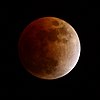February 2008 lunar eclipse
| Total eclipse | |||||||||||||||||
 Telescopic view, from North Billerica, Massachusetts at 3:25 UT, near greatest eclipse. | |||||||||||||||||
| Date | February 21, 2008 | ||||||||||||||||
|---|---|---|---|---|---|---|---|---|---|---|---|---|---|---|---|---|---|
| Gamma | −0.3992 | ||||||||||||||||
| Magnitude | 1.1081 | ||||||||||||||||
| Saros cycle | 133 (26 of 71) | ||||||||||||||||
| Totality | 49 minutes, 46 seconds | ||||||||||||||||
| Partiality | 205 minutes, 28 seconds | ||||||||||||||||
| Penumbral | 339 minutes, 3 seconds | ||||||||||||||||
| |||||||||||||||||
A total lunar eclipse occurred at the Moon’s descending node of orbit on Thursday, February 21, 2008,[1] with an umbral magnitude of 1.1081. A lunar eclipse occurs when the Moon moves into the Earth's shadow, causing the Moon to be darkened. A total lunar eclipse occurs when the Moon's near side entirely passes into the Earth's umbral shadow. Unlike a solar eclipse, which can only be viewed from a relatively small area of the world, a lunar eclipse may be viewed from anywhere on the night side of Earth. A total lunar eclipse can last up to nearly two hours, while a total solar eclipse lasts only a few minutes at any given place, because the Moon's shadow is smaller. The Moon's apparent diameter was near the average diameter because it occurred 7.2 days after perigee (on February 13, 2008, at 20:00 UTC) and 6.8 days before apogee (on February 27, 2008, at 20:30 UTC).[2]
Visibility
The eclipse was completely visible over North and South America, west Africa, and western Europe, seen rising over much of the Pacific Ocean and setting over much of Africa, eastern Europe, and west, central, and south Asia.[3]
The bright star Regulus of Leo and the planet Saturn were prominent very near the Moon during the total eclipse portion. Shortly before the eclipse began, Regulus was occulted by the Moon in parts of the far Southern Atlantic Ocean and Antarctica.

|
 Hourly motion shown right to left |
 The Moon's hourly motion across the Earth's shadow in the constellation of Leo. |
 Visibility map | ||
Timing
The Moon entered the penumbral shadow at 0:36 UTC, and the umbral shadow at 1:43. Totality lasted for 50 minutes, between 3:01 and 3:51. The Moon left the umbra shadow at 5:09 and left the penumbra shadow at 6:16.[4]
| Event | North and South America | Europe and Africa | ||||||||
|---|---|---|---|---|---|---|---|---|---|---|
| Evening of February 20th | Morning of February 21st | |||||||||
| AKST (-9h) |
PST (-8h) |
MST (-7h) |
CST (-6h) |
EST (-5h) |
AST (-4h) |
GMT (0h) |
CET (+1h) |
EET (+2h) | ||
| P1 | Penumbral began | Under Horizon | Under Horizon | Under Horizon | 18:36 | 19:36 | 20:36 | 0:36 | 1:36 | 2:36 |
| U1 | Partial began | Under Horizon | Under Horizon | 18:43 | 19:43 | 20:43 | 21:43 | 1:43 | 2:43 | 3:43 |
| U2 | Total began | Under Horizon | 19:01 | 20:01 | 21:01 | 22:01 | 23:01 | 3:01 | 4:01 | 5:01 |
| Mid-eclipse | 18:26 | 19:26 | 20:26 | 21:26 | 22:26 | 23:26 | 3:26 | 4:26 | 5:26 | |
| U3 | Total ended | 18:51 | 19:51 | 20:51 | 21:51 | 22:51 | 23:51 | 3:51 | 4:51 | Set |
| U4 | Partial ended | 20:09 | 21:09 | 22:09 | 23:09 | 0:09 | 1:09 | 5:09 | Set | Set |
Images
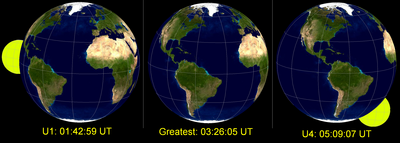 These simulated views of the Earth from the center of the Moon during the lunar eclipse show where the eclipse is visible on Earth. |
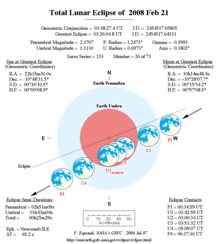
Gallery
Composites
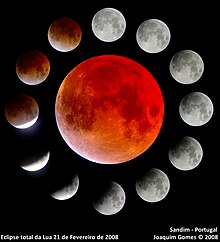 Eclipse observed from Sandim, Portugal. 41°02′22″N 8°30′50″W / 41.03944°N 8.51389°W. |
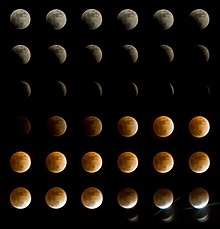 Eclipse observed from Regina, Saskatchewan. Each image is roughly taken 5 minutes apart. |
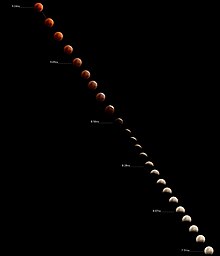 Images taken in 3-5 minute Intervals - from Bradley, Illinois. |
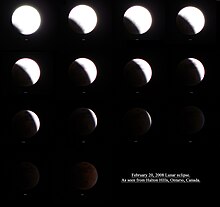 Eclipse observed from Halton Hills, Ontario. From 01:47 to 03:15 UTC, each image is roughly taken 5min apart. |
Eclipse observed from Winnipeg, Manitoba | |
Lunar eclipse observed from Burlington, Ontario | |
 Observed from Baltimore, Maryland, from 2:30 to 3:01 UTC. Lunar north is near left. | |
North America
Canada
- Eclipse Observed from Burlington, Ontario, at 2:00 UTC.
- Eclipse observed from Victoria, British Columbia, at 2:49 UTC. Lunar north is near top-left.
- Eclipse observed from Victoria, British Columbia at 2:56 UTC, just prior to total. Lunar north is near top-left.
- Eclipse observed from Salmon Arm, Canada at 3:11 UTC. Lunar north is near top-left.
- Eclipse observed from Burlington, Ontario at 4:05 UTC.
USA (west)
- Eclipse observed from Salem, Oregon. Lunar north is near top-left.
- Observed from Urbana, Illinois, at 3:06 UTC. Lunar north is near top-left.
- Observed from Boulder, Colorado, at 4:17 UTC. Lunar north is near top-left. Mare Humorum appears at bottom, Tycho's rays at bottom right.
USA (east)
- Moon observed from West Hartford, Connecticut, at 1:42 UTC. Lunar north is left.
- Eclipse observed from Philadelphia, Pennsylvania, at 2:49 UTC.
- Eclipse observed from Millersville, Pennsylvania, at 3:15 UTC. Lunar north is near left.
- Eclipse observed from West Hartford, Connecticut, at 3:17 UTC. Lunar north is near top-left.
- Eclipse observed from West Hartford, Connecticut, at 3:18 UTC. Lunar north is near top-left.
- Eclipse observed from Philadelphia, Pennsylvania at 3:36 UTC. Lunar north is top-left.
- Eclipse observed from Wellesley, Massachusetts, at 3:52 UTC
- Eclipse observed from Fredericksburg, Virginia, at 3:57 UTC.
South America
- Eclipse observed from São Joaquim, Brazil at 3:52 UTC.
Europe and Africa
- Eclipse observed from Rostock, Germany, at 1:50 UTC. Lunar north is near top.
- Eclipse observed from Sasolburg, South Africa - around 2:55 UTC. Lunar north is right.
- Eclipse observed from Prague, Czech Republic at 3:41 UTC
Eclipse details
Shown below is a table displaying details about this particular solar eclipse. It describes various parameters pertaining to this eclipse.[6]
| Parameter | Value |
|---|---|
| Penumbral Magnitude | 2.14698 |
| Umbral Magnitude | 1.10809 |
| Gamma | -0.39923 |
| Sun Right Ascension | 22h15m30.0s |
| Sun Declination | -10°48'31.3" |
| Sun Semi-Diameter | 16'10.5" |
| Sun Equatorial Horizontal Parallax | 08.9" |
| Moon Right Ascension | 10h14m48.5s |
| Moon Declination | +10°28'07.6" |
| Moon Semi-Diameter | 15'34.2" |
| Moon Equatorial Horizontal Parallax | 0°57'08.5" |
| ΔT | 65.5 s |
Eclipse season
This eclipse is part of an eclipse season, a period, roughly every six months, when eclipses occur. Only two (or occasionally three) eclipse seasons occur each year, and each season lasts about 35 days and repeats just short of six months (173 days) later; thus two full eclipse seasons always occur each year. Either two or three eclipses happen each eclipse season. In the sequence below, each eclipse is separated by a fortnight.
| February 7 Ascending node (new moon) |
February 21 Descending node (full moon) |
|---|---|
 |

|
| Annular solar eclipse Solar Saros 121 |
Total lunar eclipse Lunar Saros 133 |
Related eclipses
Eclipses in 2008
- An annular solar eclipse on February 7.
- A total lunar eclipse on February 21.
- A total solar eclipse on August 1.
- A partial lunar eclipse on August 16.
Metonic
- Preceded by: Lunar eclipse of May 4, 2004
- Followed by: Lunar eclipse of December 10, 2011
Tzolkinex
- Preceded by: Lunar eclipse of January 9, 2001
- Followed by: Lunar eclipse of April 4, 2015
Half-Saros
- Preceded by: Solar eclipse of February 16, 1999
- Followed by: Solar eclipse of February 26, 2017
Tritos
- Preceded by: Lunar eclipse of March 24, 1997
- Followed by: Lunar eclipse of January 21, 2019
Lunar Saros 133
- Preceded by: Lunar eclipse of February 9, 1990
- Followed by: Lunar eclipse of March 3, 2026
Inex
- Preceded by: Lunar eclipse of March 13, 1979
- Followed by: Lunar eclipse of January 31, 2037
Triad
- Preceded by: Lunar eclipse of April 22, 1921
- Followed by: Lunar eclipse of December 21, 2094
Lunar eclipses of 2006–2009
This eclipse is a member of a semester series. An eclipse in a semester series of lunar eclipses repeats approximately every 177 days and 4 hours (a semester) at alternating nodes of the Moon's orbit.[7]
The lunar eclipses on July 7, 2009 (penumbral) and December 31, 2009 (partial) occur in the next lunar year eclipse set.
| Lunar eclipse series sets from 2006 to 2009 | ||||||||
|---|---|---|---|---|---|---|---|---|
| Descending node | Ascending node | |||||||
| Saros | Date Viewing |
Type Chart |
Gamma | Saros | Date Viewing |
Type Chart |
Gamma | |
113
|
2006 Mar 14
|
Penumbral
|
1.0211 | 118
|
2006 Sep 7
|
Partial
|
−0.9262 | |
123
|
2007 Mar 03
|
Total
|
0.3175 | 128
|
2007 Aug 28
|
Total
|
−0.2146 | |
133
|
2008 Feb 21
|
Total
|
−0.3992 | 138
|
2008 Aug 16
|
Partial
|
0.5646 | |
143
|
2009 Feb 09
|
Penumbral
|
−1.0640 | 148
|
2009 Aug 06
|
Penumbral
|
1.3572 | |
Saros 133
This eclipse is a part of Saros series 133, repeating every 18 years, 11 days, and containing 71 events. The series started with a penumbral lunar eclipse on May 13, 1557. It contains partial eclipses from August 7, 1683 through December 17, 1899; total eclipses from December 28, 1917 through August 3, 2278; and a second set of partial eclipses from August 14, 2296 through March 11, 2639. The series ends at member 71 as a penumbral eclipse on June 29, 2819.
The longest duration of totality will be produced by member 35 at 101 minutes, 41 seconds on May 30, 2170. All eclipses in this series occur at the Moon’s descending node of orbit.[8]
| Greatest | First | |||
|---|---|---|---|---|
| The greatest eclipse of the series will occur on 2170 May 30, lasting 101 minutes, 41 seconds.[9] | Penumbral | Partial | Total | Central |
| 1557 May 13 |
1683 Aug 07 |
1917 Dec 28
|
2098 Apr 15
| |
| Last | ||||
| Central | Total | Partial | Penumbral | |
| 2224 Jul 01 |
2278 Aug 03 |
2639 Mar 11 |
2819 Jun 29 | |
Eclipses are tabulated in three columns; every third eclipse in the same column is one exeligmos apart, so they all cast shadows over approximately the same parts of the Earth.
| Series members 15–36 occur between 1801 and 2200: | |||||
|---|---|---|---|---|---|
| 15 | 16 | 17 | |||
| 1809 Oct 23 | 1827 Nov 03 | 1845 Nov 14 | |||
| 18 | 19 | 20 | |||
| 1863 Nov 25 | 1881 Dec 05 | 1899 Dec 17 | |||
| 21 | 22 | 23 | |||
| 1917 Dec 28 | 1936 Jan 08 | 1954 Jan 19 | |||

|

|

|

|

|

|
| 24 | 25 | 26 | |||
| 1972 Jan 30 | 1990 Feb 09 | 2008 Feb 21 | |||

|

|

|

|

|

|
| 27 | 28 | 29 | |||
| 2026 Mar 03 | 2044 Mar 13 | 2062 Mar 25 | |||

|

|

|

|
||
| 30 | 31 | 32 | |||
| 2080 Apr 04 | 2098 Apr 15 | 2116 Apr 27 | |||

|

|

|

|
||
| 33 | 34 | 35 | |||
| 2134 May 08 | 2152 May 18 | 2170 May 30 | |||
| 36 | |||||
| 2188 Jun 09 | |||||
Metonic series
This is the fourth of five Metonic lunar eclipses.
The Metonic cycle repeats nearly exactly every 19 years and represents a Saros cycle plus one lunar year. Because it occurs on the same calendar date, the Earth's shadow will in nearly the same location relative to the background stars.
| Descending node | Ascending node | |||||
|---|---|---|---|---|---|---|
| Saros | Date | Type | Saros | Date | Type | |
| 103 | 1951 Feb 21.88 | Penumbral | 108 | 1951 Aug 17.13 | Penumbral | |

|

| |||||
| 113 | 1970 Feb 21.35 | Partial | 118 | 1970 Aug 17.14 | Partial | |
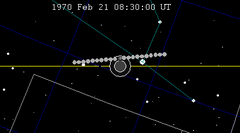
|
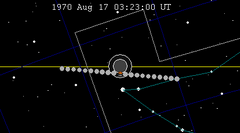
| |||||
| 123 | 1989 Feb 20.64 | Total | 128 | 1989 Aug 17.13 | Total | |
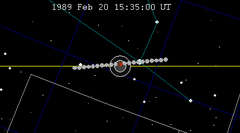
|
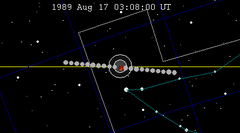
| |||||
| 133 | 2008 Feb 21.14 | Total | 138 | 2008 Aug 16.88 | Partial | |

|
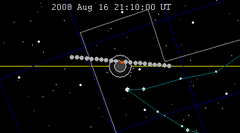
| |||||
| 143 | 2027 Feb 20.96 | Penumbral | 148 | 2027 Aug 17.30 | Penumbral | |
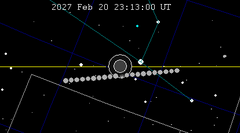
|
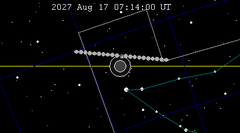
| |||||
Half-Saros cycle
A lunar eclipse will be preceded and followed by solar eclipses by 9 years and 5.5 days (a half saros).[10] This lunar eclipse is related to two annular solar eclipses of Solar Saros 140.
| February 16, 1999 | February 26, 2017 |
|---|---|
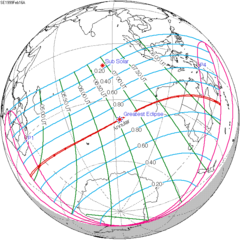
|
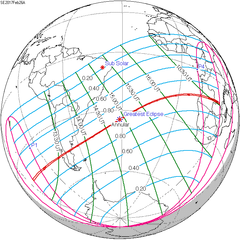
|
See also
- List of lunar eclipses in the 21st century
- Lists of lunar eclipses
- Solar eclipse
- File:2008-02-21 Lunar Eclipse Sketch.gif Chart
Notes
- ^ "February 20–21, 2008 Total Lunar Eclipse (Blood Moon)". timeanddate. Retrieved 14 November 2024.
- ^ "Moon Distances for London, United Kingdom, England". timeanddate. Retrieved 14 November 2024.
- ^ "Total Lunar Eclipse of 2008 Feb 21" (PDF). NASA. Retrieved 14 November 2024.
- ^ "Total lunar eclipse of 2008 Feb 21" (PDF). NASA. 21 February 2008. Eclipse Predictions by Fred Espenak, NASA's GSFC
- ^ "NASA - Total Lunar Eclipse: February 20, 2008". 2008. Archived from the original on 21 February 2008. Retrieved 21 February 2008.
- ^ "Total Lunar Eclipse of 2008 Feb 21". EclipseWise.com. Retrieved 14 November 2024.
- ^ van Gent, R.H. "Solar- and Lunar-Eclipse Predictions from Antiquity to the Present". A Catalogue of Eclipse Cycles. Utrecht University. Retrieved 6 October 2018.
- ^ "NASA - Catalog of Lunar Eclipses of Saros 133". eclipse.gsfc.nasa.gov.
- ^ Listing of Eclipses of series 133
- ^ Mathematical Astronomy Morsels, Jean Meeus, p.110, Chapter 18, The half-saros
External links
- NASA: Total Lunar Eclipse: February 20, 2008
- NASA Saros series 133
- 2008 Feb 21 chart: Eclipse Predictions by Fred Espenak, NASA/GSFC
- Hermit eclipse (Ian Cameron Smith) Total Lunar Eclipse: February 21, 2008
- Photos
- Astronet: Information and live webcasts of the February 20-21 total lunar eclipse from the Netherlands, Belgium, Germany, Spain and Argentina
- NASA Astronomy Picture of the Day: February 20, 2008, February 22, 2008 March 1, 2008
- Sky&Telescope, Eclipses of 2008
- Example Images from Dr. Eric S. Ackerman - Fort Lauderdale, Florida Archived 26 February 2008 at the Wayback Machine
- Various Animations of the Eclipse Astronight Observatory - Billerica MA
- SpaceWeather Lunar Eclipse Photo Gallery: February 20, 2008
- Philadelphia, PA: A timelapse of the total lunar eclipse on February 20th, 2008. Recorded with still images.
- Feature No Longer Available | Weather Underground [1]













